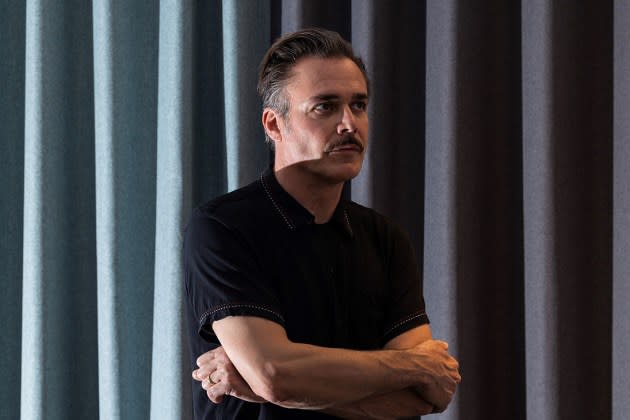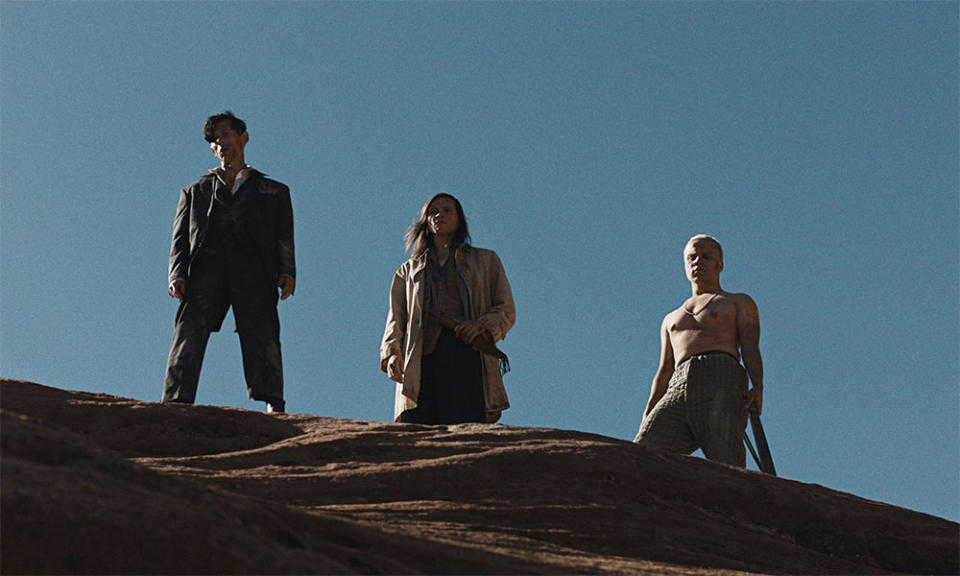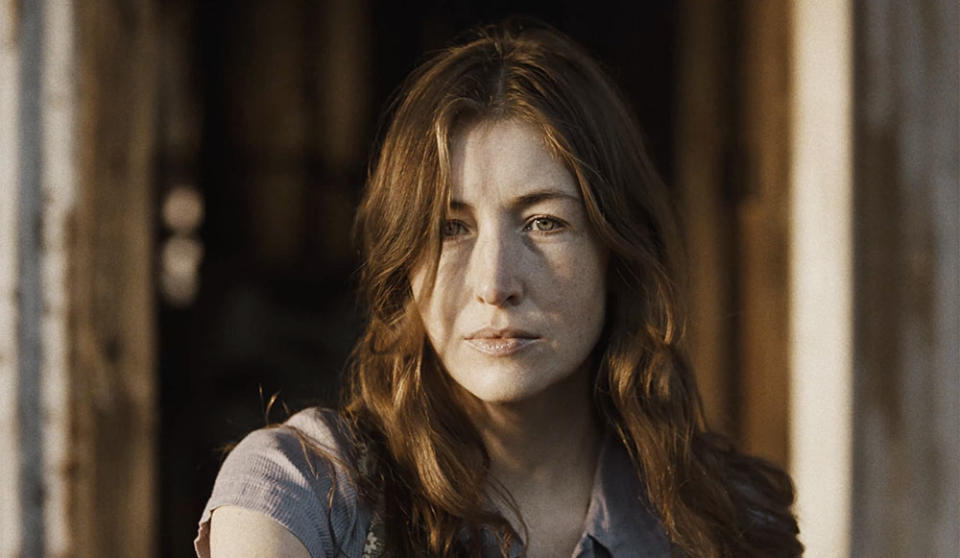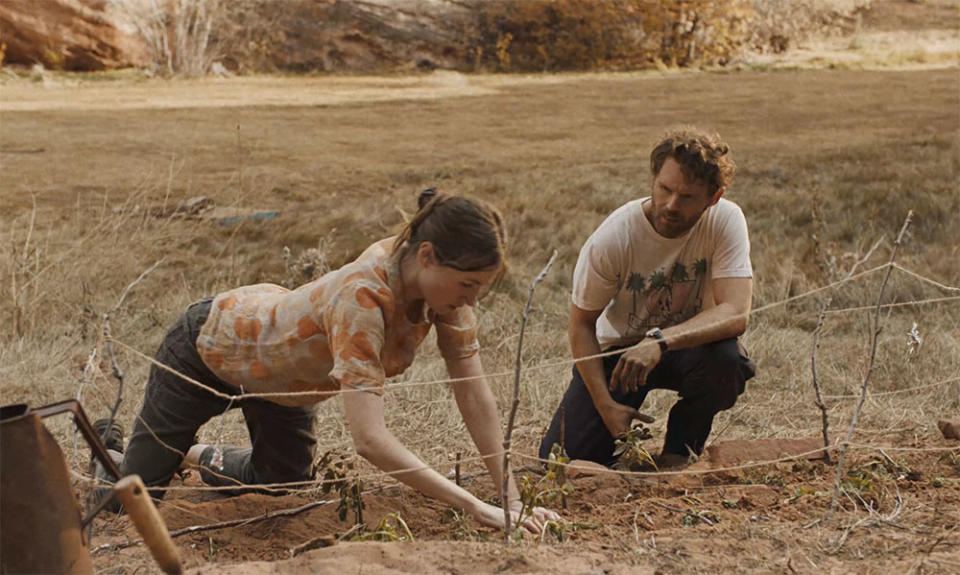‘The Seeding’ Filmmaker Barnaby Clay Talks the Challenges of Indie Horror and the Roads Not Taken
- Oops!Something went wrong.Please try again later.
- Oops!Something went wrong.Please try again later.
- Oops!Something went wrong.Please try again later.
- Oops!Something went wrong.Please try again later.
- Oops!Something went wrong.Please try again later.

Independent filmmaking is not for the faint of heart, and writer-director Barnaby Clay just spent eight years learning that lesson en route to his first narrative feature, The Seeding.
Clay began his directorial career in music videos for artists such as Rihanna, the Yeah Yeah Yeahs and Gnarls Barkley, as well as short films and documentaries, like the Mick Rock doc, SHOT! Stories of directors making the jump from music videos to feature films used to be more common when music videos were not only as visible as any movie or album release, but were also treated with nearly the same cultural cachet. The transition still happens, but not to the degree that it once did when the likes of David Fincher, Sofia Coppola and Jonathan Glazer launched their filmmaking careers off of their award-winning and artistic exploits in music videos.
More from The Hollywood Reporter
Gigi Hadid and Emily Ratajkowski Rock Massive Shoulder Pads at Jacquemus
Microsoft Sees Gaming Revenue Boost From Activision Blizzard Acquisition
Fortunately for Clay, he has two friends who successfully made the leap from videos to features many years earlier, and they generously offered counsel during his quest to bring his psychological horror-thriller to life.
“[Ana Lily Amirpour] was actually really instrumental. I also spoke to Spike Jonze, who … gave me all levels of advice,” Clay tells The Hollywood Reporter. “Ana Lily and Spike both helped to get the script to certain actors, not the actors who ended up in the film, but to certain other actors. So every little bit helps, and it’s such an asset to have people who will be generous with their time and guide you.”
The Seeding centers on Wyndham Stone (Scott Haze), who ventures out into the desert to photograph a solar eclipse. On his way out, he encounters a purported lost child, and in an attempt to help the boy find his way, Wyndham himself is led astray. Desperate for help, Wyndham comes across a nearby shack at the bottom of a canyon, and a single woman (Kate Lyn Sheil’s Alina) offers him food and a bed until the next day. However, the following morning becomes many mornings, as the ladder system that Wyndham used to drop down into the precipitous canyon was removed by a group of desert kids, including the one who misled him from the start.
The British filmmaker developed an earlier version of the movie that was supposed to enter production with a different cast and price point until the pandemic forced him to retool at a lower budget.
“I called my producer [Brian R. Etting] from the desert on Thanksgiving and said, ‘Can we do it for half the amount of money?’ And he said, ‘Maybe. Let’s try,’” Clay recalls. “And I said, ‘Well, do you think I should rewrite it?’ And he was just like, ‘Ah, just keep everything in there and we’ll see what we can do.’ But I’m not sure that was the best way of dealing with it, because, outside of shooting the film, I basically spent every moment rewriting it.”
Below, during a recent conversation with THR, Clay discusses the many other challenges he faced during production, as well as the story choices he nearly made. Then he steps into spoiler territory by shedding light on some of the implied relationships in the film.
Being trapped in one location with regular supply deliveries suggests that The Seeding was a pandemic brainchild, but that wasn’t the case, was it?
(Laughs.) Well, it was short during the pandemic, so I’m pretty certain that it seeped in there somehow. But, yeah, it did not come from that. We actually shot it in that weird period where it was just like, “The pandemic is over!” And then, by the time we all got back from Utah, Omicron suddenly hit. So we got it done in this tiny little period. We still went through all the Covid protocols, and there was this sense of like, “Oh, we’re free,” but we were trapped in this canyon at the same time. So there were definitely a lot of parallels.
There was a previous iteration of The Seeding with a bigger budget and different cast. Did you have to kill any darlings at the lower price point?
We did have to do that, yeah. I called my producer [Brian R. Etting] from the desert on Thanksgiving and said, “Look, we are not going to get the money to do this how we want to do it. Can we do it for half the amount of money?” And he said, “Maybe. Let’s try.” And I said, “Well, do you think I should rewrite it?” And he was just like, “Ah, just keep everything in there and we’ll see what we can do.” But I’m not sure that was the best way of dealing with it, because, outside of shooting the film, I basically spent every moment rewriting it. We shot six-day weeks in southern Utah, and while everybody was off hiking or climbing, I was sitting in my motel room trying to rewrite the entire final act of the film.
The ending of the film completely changed. I had a very different ending in the shooting script, and after the end of the first week, we’d fallen pretty far behind and it was pretty obvious that we were not going to be able to do it. It was longer and way more involved with all the kids. There were stunts. There was also a scene that happened in L.A. afterwards. So it was a whole different ending that was slightly more happy, but also bittersweet. So I had to rethink it, and interestingly enough, the ending that is now in the film was the first draft’s ending. It was my second draft where I was just like, “Ah, shit, maybe this is too bleak. I’ve put the audience through this for 90 minutes, so do I really want to give them that at the end?”
So I moved away from the bleak ending, and then through all of these problems and not having enough time, I was like, “Maybe that’s the way it should be.” I never shared this ending with anybody, and as I started selling my producer and cast on it, the more I was selling myself on it. And by the time we got to shoot it, I was just like, “This is the ending it should have been. I don’t know what I was thinking.”

Did you base this desert cult on any real-life groups or stories?
When I was writing it, I always wanted to keep one foot in reality. I’d stop myself and just be like, “Is this at all plausible?” And then I’d look at the news or something, and sure enough, you’d see some awful headline of some family keeping their kids trapped in the basement or whatever. So it wasn’t necessarily this story, but it’s America and crazy stuff happens here. It’s a big enough place where things can take place without people really being aware of it. And when you’re out in the desert and you just drive past something, you’re like, “What is really going on over there?” So there wasn’t anything specific, but the biggest influence was nature and something like a termite colony. I know it sounds ridiculous, but it’s about how hierarchical structures within nature are basically us on a very simplified level. So I based a lot of these ideas on that.
Given the elements, it looked like you experienced a particularly brutal shoot in Utah. Overall, what was the toughest shot to capture?
At the end of the second act and into the third act, there’s a pretty brutal death involving one of the kids, and that was the one I fretted about the most. Interestingly, it turned out to be one of the easier things in a strange way. I just built this insane shot up too much: “How are we going to do this? How are we going to make this feel real? We don’t have a lot of money, and we don’t have a lot of time.” So we had to film this stunt in the sky and this heavy dramatic scene on the ground underneath it between my two leads, and while it seemed like it was going to be a massive challenge, it was the one day where everything went right.
The actual hardest thing to shoot was the climax sequence, because we messed up the timing of it. We had a day to shoot the whole scene, and somehow, we ended up giving ourselves only two hours to shoot the entire climax of the film. It was insane. So it was a bad call and kind of a disaster. We’d shot maybe an eighth of the scene, and we were like, “How are we going to finish it?” We’d shot it at a specific time of day that was [overcast], and everybody was pretty depressed, including me. I was eating a pack of depression, and when you are working on that level of stress, it’s a nightmare. But it also fires your brain into creative overdrive.
So I came up with a solution that I feel very happy with. The script and the film both start with a solar eclipse, but there was no solar eclipse at the end of the film, originally. So that was my way of basically shooting half the scene in this muddy darkness and the other half in bright daylight. Thematically, it just made perfect sense and it really adds to it, even if it’s not particularly plausible that you would have two solar eclipses within that period of time. But who cares. Visually, cinematically and thematically, it just made perfect sense. So we went from disaster to something that really paid off in the end.

Wyndham Stone (Scott Haze) begins the film with a good enough nature to help out this supposedly lost kid, but understandably, an ugly side of him comes out as the days of entrapment pile up. I actually got to a point where I wondered if maybe he had it coming to some degree. My take ultimately changed by the end, but did you actually want us to debate whether he had it coming?
Initially, I’d written these scenes in a very typical way for this type of movie. He drives out to the desert, he’s on the phone with his office, just establishing the character’s backstory. But, again, we didn’t have the money in the end to do that. We probably could have found it, but we certainly couldn’t have done it in Utah. If it was second unit back in Los Angeles, maybe we could have done it, but I realized that I just wanted to go in raw with the character and experience it that way.
I also wanted him to be somebody who was socially awkward. I shared this backstory with Scott, as [Wyndham] lives and works in the city. He has a professional life, but he’s not a social person. He has spent much of his time trying to avoid interaction, trying to get away and be on his own, and not wanting to be a family man. During casting, I was very specific about the age. I wanted him to be at an age where he’s established that he doesn’t want to be a family man or a father. So he’s fine with it until he’s put in this situation, and then he begins to realize how sad his life was. I just wanted him to be a bit more complex than a nice guy thrown into a shitty situation.
I also wanted [Kate Lyn Sheil’s Alina] to be a character who you didn’t really know that much about. She has one major motivation, obviously, but at the same time, there are moments where there’s a genuine questioning between her and her motivation and the situation. Is there a point within there where she actually likes him? Is there a version of the story where they live happily ever after? So I didn’t go out of my way to make him too awful, but I didn’t want to make him too clean-cut where we are just rooting for him the whole time. Whether that’s a good thing or a bad thing, I don’t know, but it’s interesting as an audience member to be a little confused about whom you should be rooting for at certain points. Some people like that, but some people don’t.

Kate Lyn Shiel has a lot of genre cred from her work with Amy Seimetz and that family tree of filmmakers, and she’s as compelling as ever here. As you just touched on, we don’t learn too much about Alina within the text of the film, but how deep did you go in defining Alina’s backstory for the sake of Kate Lyn’s performance?
Between the two of us, we created a pretty solid history for her. There’s definitely a balancing act within the film about how much information I wanted to give away about her and her life, Wyndham and his life, this society and how it works, and what are the myths and the rules within it. I tried to err a little bit towards less is more, but we went into it. If she had a question, she would obviously ask me and we would generally find the right spot.
When I first had a Zoom conversation with Kate, she had just a little air of mystery about her. She was like, “I love the script. I love this character.” And I thought to myself, “But do you really love this character?” (Laughs.) She’s sometimes quite hard to read, but when I stepped away after that initial conversation, I was just like, “Oh, that’s a real asset for this role. She should have this slightly unknowable personality.”
As a writer, you obviously have to surrender to the actor and their interpretation, but I never saw Alina as this feral beast or anything like that. Even though she lives a certain way, I wanted her to care about her environment and her appearance, which another version of the character wouldn’t do. Kate also has a poise and a way of being that is so un-feral, so I don’t know how that would’ve worked, but it’s just more interesting this way. You would expect a much more ruffian version of her, but she just brings this inherent intelligence to her and the performance. And it’s just so interesting because it’s not what you expect.
As I was watching this movie involving cults and desert-based insanity, I kept thinking that it would make for a great double feature with The Bad Batch.
(Laughs.)
Well, sure enough, I then noticed that you thanked Bad Batch director Ana Lily Amirpour in the credits. Did you receive some helpful notes from her and some other filmmakers along the way?
Yeah, Ana Lily was really helpful. I shared the script with her, and she was one of the people I ran to when we didn’t have the money, initially. I was like, “What am I going to do?” In fact, she was actually really instrumental. We searched for this location for a long time, and we looked everywhere around the world. We looked anywhere that made visual sense, but also financial sense. So we looked in Romania. where there was a dormant volcano. We also knew that we’d get cheap crews there or whatever, and we’d be able to shoot more than the 19 days we had. But I remember talking to Ana Lily about it and her just saying, “It’s your first film. Shoot it somewhere here where people speak your language.” She even said that they have great tax credits in Utah, so we checked out Utah and we ended up shooting there. So she was very, very helpful.
I also spoke to Spike Jonze, who’s a friend of mine, and he was just great in terms of talking about working with kids and all sorts of things. He was very, very generous. We got together and had lunch, and we just went through it all. He gave me all levels of advice. So I received so much help from people, which was really lovely. Also, with casting, Ana Lily and Spike both helped to get the script to certain actors, not the actors who ended up in the film, but to certain other actors. So every little bit helps, and it’s such an asset to have people who will be generous with their time and guide you.
Your composer, Tristan Bechet, is your cousin, and he delivered a creepily evocative score. That said, because of who you are [husband to Yeah Yeah Yeahs’ Karen O] and your past work in music videos, I’m assuming you know a ton of musicians who could’ve also delivered a uniquely great score. So how easy or complicated was that decision?
It was easy, but not just because of the familial tie. I knew from the very beginning that there was only one person for this score, and it was [Tristan]. He speaks a certain musical language that I knew was right for this film, and we are exactly the same age as well. If there’s a straightforward route, he’s going to go [another] way. He’s always just looking for the more interesting, nuanced version of what that could possibly be. Sometimes, it’s wrong and maybe he should have gone with the more direct version, but it always leads to an interesting conversation. So I knew he would just nail it, and he did.
After my wife, he was probably the second person to read the script. He liked it, but I knew it was in his wheelhouse anyway. So, before I even cast the film, he probably sent me 30 pieces of music to work with. And then, once I had cast the film and we got into pre-production, I selected five pieces of his music and shared them with everybody. It’s an incredible tool and a huge help to be able to say, “Okay, you’ve read the script and seen my look book, but listen to this. Sonically, this is the film.” So everybody, from the cast to my key crew, had that idea going into it, and it was a very easy decision that worked out great.

[Writer’s Note: The following final question and answer contains spoilers.]
You mentioned earlier that Wyndham and Alina could have gone another way and maybe he even lived happily ever after, but the death of Lepus (Thatcher Jacobs) was obviously the turning point. Wyndham gambled with his life in trying to gain an ally, and Alina went ballistic in response. She then attacked Wyndham and turned him into a caged animal. Lepus was clearly her son, right?
Yes, she is the mother. She is the mother of all of them, barring the oldest kid. They are all from different dads, and it was very important when we were casting to choose people who all look different. I don’t know whether there’s any resemblance to [Alina] in any of them, but the idea was that she is really the spawn of them all. The scene where all the boys come down at night and Wyndham is locked in the cage, there was a version of that where he wakes up from his sleep and the first thing he sees are flashing lights above. And then he sees a park ranger down in the canyon, and he excitedly thinks he’s being saved. But then he sees some other older men, and you realize that they’re what I call “the Elders.” They are basically the spawn of Alina’s mother and grandmother, and they’re all living on the fringe of the desert somewhere.
There was another idea I was playing with where Wyndham escapes at the end of the film, and then it’s a bit of an homage to The Texas Chainsaw Massacre or something. He finds this house, and when he goes inside it, there’s a bunch of old men sitting in there who are basically Alina’s uncles or whatever. I don’t know if you’ve ever seen that amazing documentary Brother’s Keeper; it was directed by the same guys [Joe Berlinger and Bruce Sinofsky] who made Metallica: Some Kind of Monster. Well, Brother’s Keeper is about this group of brothers living together in upstate New York, and it’s just brutal. It’s kind of like Grey Gardens, but to the extreme. So that was the vision that I had for this younger generation of boys. One day, they are all going to end up living together as the [new] Elders in an abandoned summer house.
***
The Seeding is currently available in select theaters and on PVOD. It also begins streaming in the U.K. on Feb. 12th.
Best of The Hollywood Reporter

